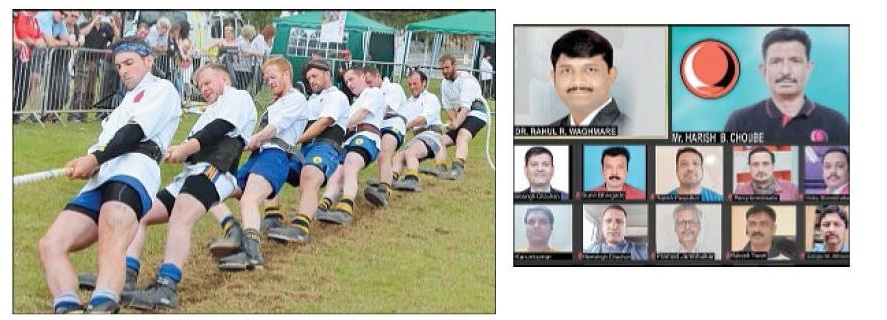Tug of war needs skills and power, says Dr Waghmare
Date :03-Jun-2021

Principal Correspondent ;
THE game of tug of war needs skills along with power. Even though the game looks simple, there are many technicalities with which it is played between two teams of eight players each, informed Dr Rahul Waghmare, Referee, Tug of War Federation of India and national tug of war medalist. Dr Waghmare was speaking during the ongoing online Karate and Sports Seminar for Physical and Spiritual Development of the Sportspersons. These seminar is being organised by Karate Budokan International (Vidarbha Region), during and is hosted by Kyoshi Harish Choube, Black Belt 7th Dan, National Chief Instructor and Examiner, Karate Budokan International. Dr Waghmare informed about the technicalities of the game. “Despite looking a simple sport, there is some technicality to it, with team members utilising a rhythm to help pull the rope in an effective way.
This is done with the help of a ‘driver’, who is not a member of the team but is in effect like a coach and gives orders of when to pull and when to rest from the sidelines. “The rope is the most important piece of equipment which approximately 11 cm in circumference and at least 33.5m long with plain, whipped ends. Other pieces of equipment that participants may use include specialist boots, elbow and knee supporters as well as belts. Dr Waghmare informed that unlike other sports there is no scoring system in tug of war. “In tug of war, there is no scoring as such. However, because teams are pitted against each other, usually a best-of-three match decides the winner. The team winning two matches is declared the victor. Each team has a mark on the end of the rope which has to be 4m from the centre. The team which is pulled by the opposition towards the centre and whose mark goes over the centre line is declared the loser. There are various weight classifications in tug of war and the mass of the eight people combined must not weigh more than that determined by the category that they are placed in. At the start of the pull, the centre line of the rope should be immediately above line marked on the ground,” Dr Waghmare explained.
Describing the rules further, Dr Waghmare said, “The rope must be pulled underarm and nobody’s elbow must go below the knee, otherwise a foul is called.” Speaking about the history of the sport, Dr Waghmare said the game finds its roots in India since ages. “There is no specific time and place in history to define the origin of the game. Countries like Egypt, India, Myanmar, Combodia used to play tug of war since ages. The origin of the game in India goes back to the 12th century AD in Orissa. The famous Sun Temple of Konark has a stone on the west wing of the structure showing the game of tug of war in progress,” informed Dr Waghmare.
“The Tug of War Federation of India was established in Ghaziabad (the then tehsil of Meerut) in 1958 by some officers of the armed forces. By 1978, it gained momentum, and the federation moved the Tug of War International Federation for recognition. The new management committee of Tug of War Federation of India headed by Gautam Kaul, Asiad Jyoti Awardee of the 9th Asian Games in New Delhi 1982, with Hari Shankar Gupta and Madan Mohan (National Youth Awardee), took up the responsibility of also organising regular national championships for men and women in different age groups (senior, junior under 19, sub-Junior, under-17 and open categories),” he concluded. The seminar concluded with interactive sessions while Renshi Karunkumar Tirpude, Karate Budokan International, proposed a vote of thanks.